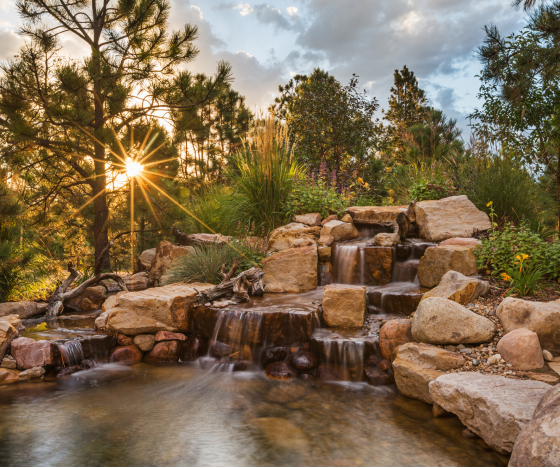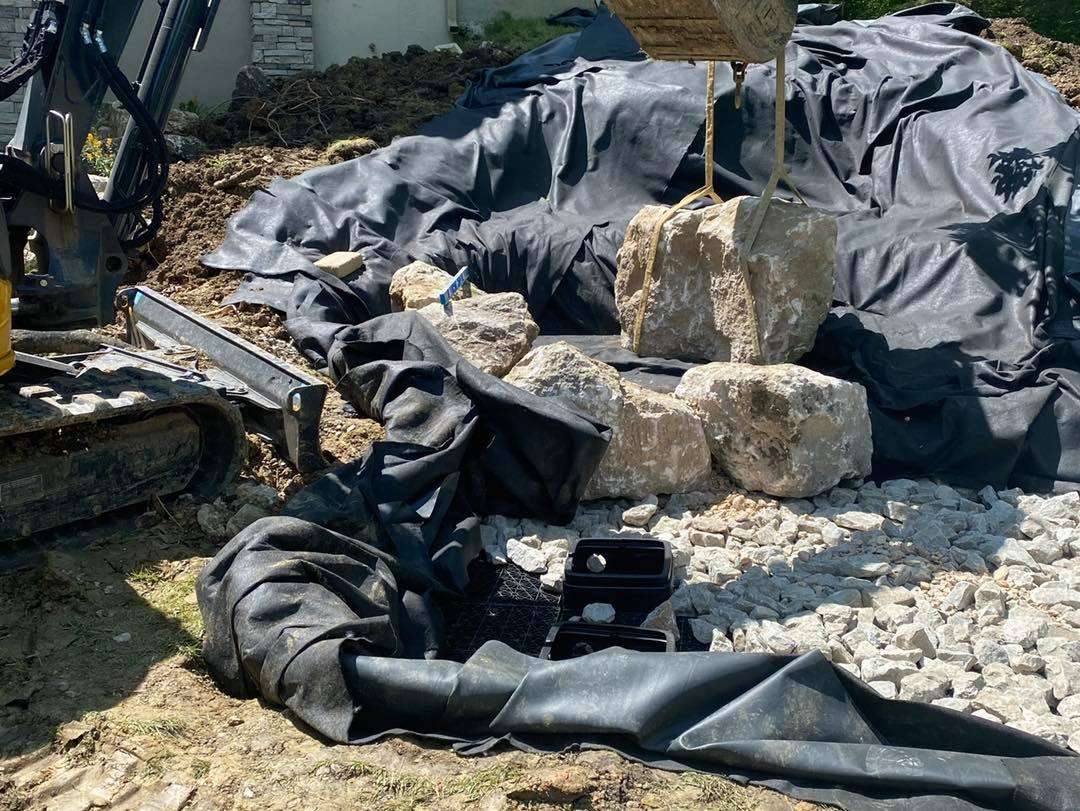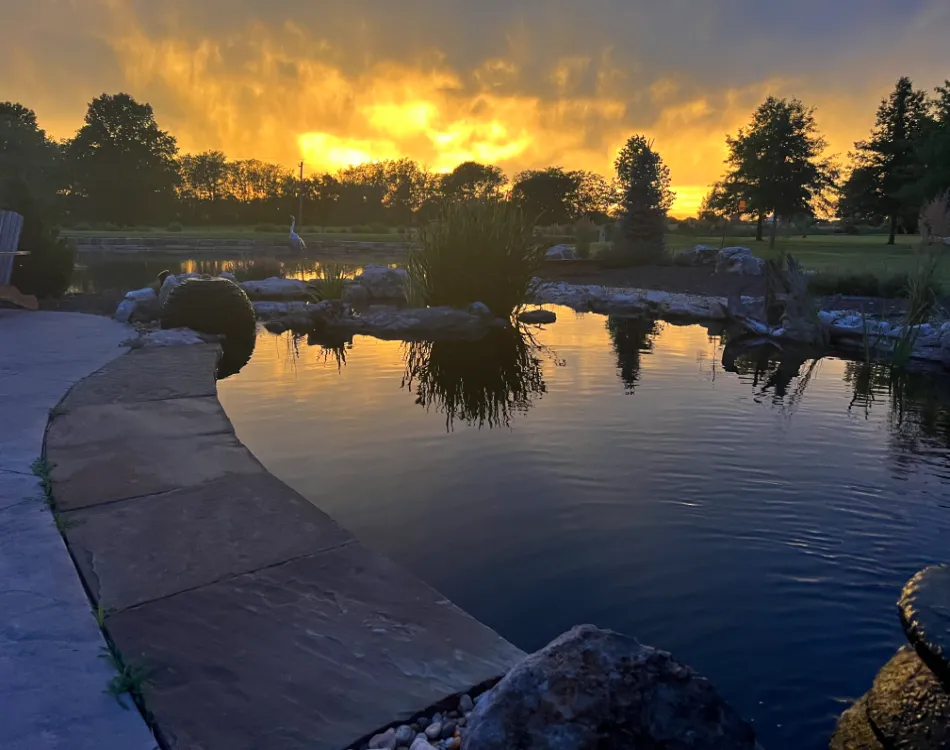
Are you worried your koi pond will look cloudy or dirty? Do you want to ensure your koi fish live in clean, clear water?
You can find out what koi pond filter options are available, what the different types are, and more. By the end of this post, you’ll have a better idea of what pond filter will work best in your pond. Then, you can find out more about how to keep your koi pond clean and clear.
Koi Pond Filter Options
| Koi Pond Filter | Bubble Bead Filter XS-1000 | Aqua Ultraviolet Ultima II | Goplus Pressure Bio Filter | Oase BioSmart Koi Filter | Oase BioTec Screenmatic Koi Filter |
|---|---|---|---|---|---|
| Pond Size in Gallons | 300-20,000 gallons | 1,000; 2,000; 4,000; 6,000 gallons | 4,000 gallons | 5,000; 10,000 gallons | 18,000; 32,000 gallons |
| Price | $825 | $800+ | $140 | $210; $417 | $1,077+ |
| Warranty | No | 1 year | No | 3 years | 2 years |
| Filtration Type | Biological, Mechanical | Biological, Mechanical | Biological, Mechanical, UV | Biological, Mechanical | Biological, Mechanical |
| Pressurized | Yes | Yes | Yes | No | No |
| Dimensions | 32″ x 10″ (diameter) | 34″ x 16″ x 16″ | 22″ x 17″ x 17″ | 30″ x 22″ x 16″ | 31″ x 23′ x 21.5″ |
| Outlet Size | .75-inches | 1.5-inches | 1.5-inches | 2.5-inches | 3-inches |
The Best Options For Koi Pond Filter Systems
1. Bubble Bead Filter XS-1000
This bead filter from AST is designed to perform high-grade mechanical filtration. It catches 100% of particles larger than 50 microns and up to 50% of those measuring 5 microns in size, guaranteeing crystal-clear water. This specific model doesn’t come with a UV light.
The AST bead filter is easy to clean, needing only a quick backwash. This reduces the pressure without needing to replace or remove any internal filters. Not only does this make maintenance simple, but it also preserves the beneficial bacteria on your biological filter.
This filter is offered in sizes from 300 gallons to a whopping 20,000! Plus, even though AST does not warranty their filter, they guarantee five-star customer service.
Pros
You’ll love the simple backwash cleaning, excellent mechanical filtration, and wide array of filter capacities available. It’s no surprise that you’ll receive superior customer service.
Cons
Unprotected from damaging UV rays and has no warranty.
2. Aqua Ultraviolet Ultima II
Aqua Ultraviolet has changed the bead filtration system by providing a solution to poor biological filtration by improving their filter.
The substrate has a lot of surface area for beneficial bacteria. Extensive testing has shown that the substrate works well in non-pressurized filtration systems when transforming ammonia.
What’s even better about the Ultima II is how effortless it is to clean with a gentle backwash. All you have to do is flip a switch on the side of the unit, and it’ll be done in a few minutes.
Despite its name, Aqua Ultraviolet’s filtration system does not come with a UV light. However, you can add an in-line version as an additional feature.
Pros
It’s powerful, easy to clean via backwash, and surprisingly affordable. Plus it comes standard with a 1-year warranty.
Cons
The UV filter isn’t a standard feature and must be added separately.
3. Goplus Pressure Bio Filter (Budget-Friendly Option)
Goplus’ small pressurized koi pond filter is a remarkable filtration system designed for optimal performance, providing outstanding results for many koi ponds.
Adding a 13-watt UV clarifier to this filter is very helpful because it uses the slow water flow to kill harmful bacteria and parasites. Cleaning is easy because the canister opens easily, allowing you access to all the parts inside.
Even so, water oxygenation is important to think about with pressurized filters. If your pond has a lot of koi fish, you might need to add activated charcoal to help the filter media.
Despite its affordability and efficiency, be cautious of the pump’s construction. It appears to have a flawed filter housing that leads to frequent leakage. GoPlus’s customer service isn’t great, and no warranty is available.
Pros
It’s affordable, easy to clean, and comes with UV filtration. It also has simple maintenance requirements.
Cons
It doesn’t oxygenate crowded ponds well, and the filter housings tend to be leaky. On top of that, it doesn’t come with a warranty and the customer service is lacking.
4. Oase BioSmart Koi Filter
This powerful non-pressurized filter has a revolutionary, multi-level biological filtering system that cleans the water. It also has an extended sludge box for higher capacity. Its foam design has been upgraded and improved to work even better.
The self-cleaning module is beneficial. You can use it to change the water flow so that debris will be separated from the filters more efficiently. Additionally, if you optimize the water level, it will reduce the chances of clogs.
Oase made the BioSmart filter bigger, but they did not fix the most significant problem–the lack of an integrated UV light. However, you can buy a separate clarifier.
Pros
Not only does it boast an immense capacity, but it also features a larger sludge box and multi-layered biological filtration. Plus, you can optimize the water level to suit your needs.
Cons
It can be quite expensive, and the lack of UV filtration may be a deal-breaker for some users.
5. Oase BioTec Screenmatic Koi Filter
Oase’s enormous non-pressurized filter system is a must-have for most ponds.
This filter has a multi-layered biological filtration media system. This means it can filter out more dirt and impurities than other filters. It also has a new foam design to ensure no water leaks out of the filter box. Additionally, the sludge box has been made larger to hold more dirt and impurities.
An upgraded feature of this system is the self-cleaning module that adjusts water flow to remove dirt and debris from filters. Also, improved water level optimization reduces the risk of clogging.
While not equipped with an integrated UV light, this filter includes a clarifier add-on option.
Pros
It offers a large capacity and enlarged sludge box, ensuring your equipment is protected from dirt or debris. In addition, its multi-layered biological filtration will keep the water clean while optimizing the water level.
Cons
Despite its benefits, this product has two notable drawbacks: it is pricey and does not come with a UV filtration system.
How To Choose The Best Koi Pond Filter System
Types Of Pond Filtration
Biological Filtration
Biological filtration works by breaking down waste material in the water. This includes both organic (such as leaves and debris) and inorganic (such as fish waste) matter. It uses beneficial bacteria to do this, which convert ammonia from the waste into nitrates. Plants and other organisms can use this as food. This helps to keep the water clean, free of odors, and reduces algae growth. Some can include a UV light to take care of microbes.
Mechanical Filtration
Mechanical filters are another important part of any pond system. It sifts out solids from the water, such as dirt, debris, sand, and even small particles like microorganisms that can cause problems such as cloudy water or algae blooms.
How Much Filtration Is The Right Amount?
It depends mostly on your pond’s size and the number of fish you have.
Generally, larger ponds need more powerful filters to keep them clean and clear. A submersible pump or external filter may be necessary if you have a large pond. This type of pump or filter should have enough power to circulate all the water in your pond several times per hour while still being able to handle any debris that accumulates in the water.
Another factor to consider when choosing a filtration system is the number of fish in your pond. Fish produce waste that needs to be removed from the water, so if you have more fish, you will need a more powerful filter.
Pressurized vs. Non-Pressurized Koi Pond Filters
Pressurized (Bead-Filters)
Pressurized filters use a system of perforated tubes filled with beads to trap and remove dirt and debris from the water. One advantage of this filter is its ability to handle larger amounts of waste. They also require less maintenance since the beads can be easily cleaned or replaced. On the downside, pressurized filters are more expensive.
Pros
They can be installed above or below ground, can process vast quantities of water, and allow more time for filtration due to slower water movement.
Cons
It can cause oxygen levels in the water to drop, leading to inadequate biological filtration. These devices are also costly.
Non-Pressurized (Box Filters)
Non-pressurized filters generally have a simpler design. They use a combination of mechanical and biological filtration to help keep your pond clean. While non-pressurized filters are usually cheaper, they also tend to require frequent cleaning due to their more traditional design.
Pros
It is easy to install and does a great job of filtering. Additionally, it’s more economical than other options. The reusable media is also self-cleansing for maximum efficiency.
Cons
It causes limited pond designs due to the filter having depth restrictions, and it needs a flat space.
FAQs About Koi Pond Filters
What Size Pump Do I Need With My Pond Filter?
The size of your pump should be proportional to the number of gallons in your koi pond. Generally speaking, you should get a pump that can filter all the water in your koi pond every hour. If you’re unsure how much water is in your pond, use this formula: length x width x average depth x 7.5 = total gallons.
How Often Do I Need To Clean My Pond Filter?
Everyone’s pond and filter system are different, so there isn’t a clear-cut timeframe for when to clean your filter. A surefire way of knowing the right time is to keep an eye on how much pressure comes out of the system. If it takes longer or decreases in strength, that’s your cue to get cleaning. It wouldn’t hurt if you consulted with manufacturers, as they may have specific instructions regarding cleaning frequency. It’s also important to know how to clean your filter.
Should I Get A Pre-Filter?
A pre-filter may be the perfect solution if your koi pond or filtration system seems overwhelmed with debris. Pre-filters trap particles before they reach the main filter, so it doesn’t get strained, and water quality is improved.
Ensure Your Pond Has The Right Filtration With Gradex
At Gradex, we understand that a well-maintained pond is guaranteed to make you proud of your outdoor space. From the design to our knowledge of the right filtration system to use, let us help you put together the perfect ecosystem for your backyard masterpiece.
We know how important your pond is, so don’t risk messing it up–call Gradex and make sure it’s done right! Fill out our contact form today and give yourself peace of mind knowing that our highly advanced filtration system will keep your pond clean and beautiful.



